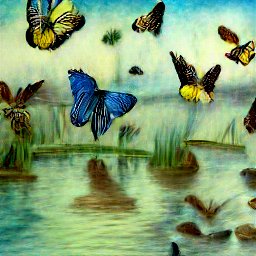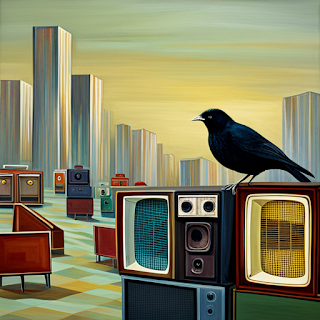Deleted Notes & Queries response: Which species exhibits the most diverse physical characteristics?
Below is a response to a question that appeared on the Notes & Queries page of The Guardian website on 17th July 2022.
The comment has since been deleted from the website.
This blog is obviously not affiliated with The Guardian. Its reference to a question that appeared in Notes & Queries is presented under the terms of fair use.
In the summer of 1976, Victor Wijngaarden, on holiday with his family in Cawdale, North Yorkshire, ran from the back door of the house that his parents rented for two weeks every June or July, to a nearby stretch of river. In his hands he clutched a bamboo pole, holding it across his chest as if it were a rifle, and he a solider charging across no-man's land, with the red fishing net at one end substituting for a bayonet.
His heart was set on the tiny black fish that he had observed, during previous years, moving in procession upstream, each migratory column aligned to a different braid of the subsurface current. At times, the veining traffic would be so dense, the water would resemble a piece of dark cloth that was in the process of unravelling and becoming threadbare.
The comment has since been deleted from the website.
This blog is obviously not affiliated with The Guardian. Its reference to a question that appeared in Notes & Queries is presented under the terms of fair use.
~
Which species exhibits the most diverse physical characteristics?
 |
| image generated by Craiyon |
His heart was set on the tiny black fish that he had observed, during previous years, moving in procession upstream, each migratory column aligned to a different braid of the subsurface current. At times, the veining traffic would be so dense, the water would resemble a piece of dark cloth that was in the process of unravelling and becoming threadbare.
“I was nine years old and was regarded as being responsible enough to visit the river without adult supervision,” he recalls.
However, when he reached the banks he was greeted by a bone-dry bed of smooth, grey pebbles. A bent sheep's skull, that had been washed to the margins, had splintered into sinewy fibres, like a piece of rotten tree trunk.
However, when he reached the banks he was greeted by a bone-dry bed of smooth, grey pebbles. A bent sheep's skull, that had been washed to the margins, had splintered into sinewy fibres, like a piece of rotten tree trunk.
An optimistic detour to a pond in a neighbouring field yielded only muddy dregs, seasoned with cow pats.
A deflated Wijngaarden returned to the riverside, where he took disconsolate swipes at passing butterflies. It was only when he ceased in these efforts, closed his eyes and - holding the bamboo cane at the far end with both hands - lazily swung the net in a full circle, that he was successful in ensnaring a fragment of blue from the summer sky.
“I took it back to my room and put it in a jam jar with some leaves,” he says. “In the afternoon I noticed that the colour was fading from its wings. Eventually they turned brown. I rationalised that it must be transforming into a moth, which I assumed was what butterflies did at night. By the evening it had wrapped its wings around its body and looked like a bit of dead seed grass.
“The following morning I was awakened by the intermittent sound of panicked flapping, strobing against glass. The butterfly had awakened, only now its wings were a lacework of lilac, tinged with yellow. Even its body shape was different. I was so alarmed that I unscrewed the lid of the jar and shook it out through the open window.”
Wijngaarden had borne witness to a phenomenon that had long been a fringe theory within the lepidopterist community: That there were butterflies capable of routinely altering their physical appearance.
A deflated Wijngaarden returned to the riverside, where he took disconsolate swipes at passing butterflies. It was only when he ceased in these efforts, closed his eyes and - holding the bamboo cane at the far end with both hands - lazily swung the net in a full circle, that he was successful in ensnaring a fragment of blue from the summer sky.
“I took it back to my room and put it in a jam jar with some leaves,” he says. “In the afternoon I noticed that the colour was fading from its wings. Eventually they turned brown. I rationalised that it must be transforming into a moth, which I assumed was what butterflies did at night. By the evening it had wrapped its wings around its body and looked like a bit of dead seed grass.
“The following morning I was awakened by the intermittent sound of panicked flapping, strobing against glass. The butterfly had awakened, only now its wings were a lacework of lilac, tinged with yellow. Even its body shape was different. I was so alarmed that I unscrewed the lid of the jar and shook it out through the open window.”
Wijngaarden had borne witness to a phenomenon that had long been a fringe theory within the lepidopterist community: That there were butterflies capable of routinely altering their physical appearance.
“For years, there was a growing suspicion that the Brownlee Butterfly Collection, which gathers together mutations that have yet to be assigned to a species, might house members of a single, superficially diverse genus that was, at the time, unidentified by science,” recalls Dr Mary Allum. “If that was the case, then logically some specimens that had already been categorised might, in reality, also belong to this species.
“I will never forget the email that I received from Gordon Neil. It was titled: 'Sorry'. I had just completed a very rewarding four year analysis of butterfly flight patterns. With no follow-up work on the cards, I had thrown myself on the mercy of the Natural History Museum Within a few sentences I knew that the next few years would be spent in rooms with no natural light, studying trays of preserved butterflies. I wrote back and said: If you want me to do this, then you're are naming it after me.”
Arca Allumus references not only the woman who doggedly sorted through hundreds of thousands of butterfly specimens, in an attempt to define the parameters of a species, but also Noah's Ark.
“The genetics of the Arca contain a library of every butterfly that ever was and ever will be,” claims the author, Nick Judelson.
“Well I think that he might be over-reaching a little,” says Allum, “but he does have a point. When folklore tells you there are butterflies that are capable of dramatically altering their appearance every few days, the scientist in you wants to dismiss it out of hand. Yet we have a species with the wherewithal to profoundly reinvent itself and we don't know how it does it. Diet and temperature appear to play a role in any new form that emerges, but a lot of the changes seem to be completely random. It is as if the species is fast-forwarding through its own evolution. They can live for up to five years in captivity, so this may be how they are extending their lives.”
She admits that the hardest part of the process was striking named species from the record:
“On three successive occasions, I had to contact Elton John's people and inform them that a butterfly named after him was no longer formally recognised by science. How can you not take that personally? It must have looked like we were cancelling him, one butterfly at a time.”
During this period, Allum underwent her own transformation:
“I lost my battle with grey hair,” she admits. “I am not a butterfly, so it will be remaining that colour.”
I hope this is of help.
“I will never forget the email that I received from Gordon Neil. It was titled: 'Sorry'. I had just completed a very rewarding four year analysis of butterfly flight patterns. With no follow-up work on the cards, I had thrown myself on the mercy of the Natural History Museum Within a few sentences I knew that the next few years would be spent in rooms with no natural light, studying trays of preserved butterflies. I wrote back and said: If you want me to do this, then you're are naming it after me.”
Arca Allumus references not only the woman who doggedly sorted through hundreds of thousands of butterfly specimens, in an attempt to define the parameters of a species, but also Noah's Ark.
“The genetics of the Arca contain a library of every butterfly that ever was and ever will be,” claims the author, Nick Judelson.
“Well I think that he might be over-reaching a little,” says Allum, “but he does have a point. When folklore tells you there are butterflies that are capable of dramatically altering their appearance every few days, the scientist in you wants to dismiss it out of hand. Yet we have a species with the wherewithal to profoundly reinvent itself and we don't know how it does it. Diet and temperature appear to play a role in any new form that emerges, but a lot of the changes seem to be completely random. It is as if the species is fast-forwarding through its own evolution. They can live for up to five years in captivity, so this may be how they are extending their lives.”
She admits that the hardest part of the process was striking named species from the record:
“On three successive occasions, I had to contact Elton John's people and inform them that a butterfly named after him was no longer formally recognised by science. How can you not take that personally? It must have looked like we were cancelling him, one butterfly at a time.”
During this period, Allum underwent her own transformation:
“I lost my battle with grey hair,” she admits. “I am not a butterfly, so it will be remaining that colour.”
I hope this is of help.
 |
| image generated by Craiyon |



Comments
Post a Comment